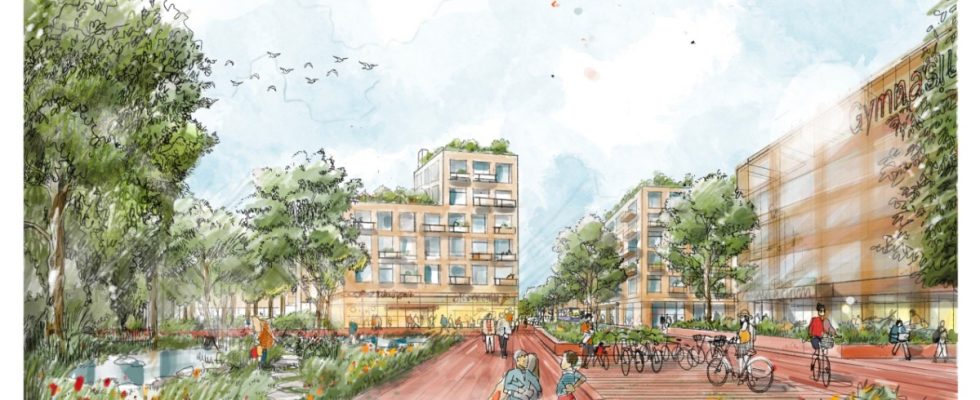A total of almost 3,000 new apartments are to be built on the northern and eastern outskirts of the city. In its most recent meeting, the planning committee decided by a large majority to obtain building permission for the two projects on Dreilingsweg and in the Ludwigsfeld housing estate. The basis are the winning designs of the architectural competitions, which are now to be developed with a view to the goals of the citizens’ initiative “Preserve green spaces”.
Up to 2000 apartments are planned in the Ludwigsfeld settlement. 1500 to 1600 people live in the existing, almost square residential area from two construction phases, the densification creates living space for 4500 to 5000 newcomers and is therefore criticized by residents and local politicians as too massive. The areas – almost 32 hectares – are mostly privately owned, the investors are private individuals associated with Patrizia Immobilien AG, the Büschl Group and PG Granatstraße 12 GmbH.
According to the design by Palais Mai Architects from Munich and Grabner Huber Lipp Landscape Architects from Freising, a “ring park” is to form the bracket between the existing and the new district, into which the last surviving barracks of the former concentration camp satellite camp will be integrated as a place of remembrance along with a history trail. A six-stream elementary school with sports areas is to be built to the north of it.
The five-storey residential buildings with two high points are grouped around irregularly shaped courtyards, shops and bars are arranged on a street between the square and the tram stop. While the tram should cross the Ringpark in the south and thus be easily accessible from the old and the new settlement, car traffic will be guided along the edge of the new quarter.
According to the planning department, the general green areas in the area add up to 6.2 hectares. According to the goals of the citizens’ initiative, which the city council adopted at the beginning of March with a green-black majority, they should not be built on. However, the draft replans a part of it, especially on Karlsfelder Straße and in the south of the existing housing estate. The planning department contrasts this with the fact that almost six hectares of new green space will be created and the biotopes on the Schwabenbächl, along Karlsfelder Straße and south of the barracks will be preserved. In addition, the new buildings offer noise protection from the motorway, the MAN test track and Karlsfelder Strasse.
“The twelfth case” in which the request for green space was not taken into account
In the discussion, the city councilors repeated their arguments for and against densification, which they had already put forward when the key data was decided a year ago. Brigitte Wolf (Die Linke) and Dirk Höpner (München-Liste) rejected the height and density of the development, Höpner called for an additional alternative proposal in accordance with the citizens’ petition and the high-rise study. Jörg Hoffmann (FDP), on the other hand, found that Munich could not afford to “give away such space”, Alexander Reissl (CSU) pointed out that retail, school locations and local transport services are only worthwhile from a certain number of inhabitants. Anna Hanusch (Greens) cited the city’s housing needs, Simone Burger (SPD) spoke of a design that was unusual with its high density, but fits in here.
On the Dreilingsweg, where Obermenzing borders on Langwied, the living area – about half of the 14-hectare planning area – was the subject of an architectural competition. The winning design by the Berlin offices MLA+ and Lohrengel Landschaft accommodates the approximately 950 mostly subsidized or low-priced apartments in often L-shaped structures that form open courtyards. A six-stream high school and a small park are also planned north-west of it. The owners are the city and Bayerische Hausbau.
The criticism from local residents focuses on the issue of traffic. They fear that the new neighbors’ cars could clog their streets because the planned neighborhood is to be designed with few cars and only buses may be allowed to drive through the central square. Now, on the basis of a unanimous motion by the Pasing-Obermenzing district committee, which the CSU took up, a continuous road from the district to the north is also being examined. However, Paul Bickelbacher (Greens) assessed their relief effect as low.
Bickelbacher sees the construction project as an opportunity to build many apartments and the much-needed high school. Its location on a general green space, said Christian Müller (SPD), makes sense and “is no longer up for debate”. Dirk Höpner, who again campaigned for the green spaces citizens’ initiative, failed with the application for alternative planning that keeps the green spaces free. He criticized that this was “unfortunately the twelfth case” in which the goals of the citizens’ initiative were not sufficiently taken into account.

